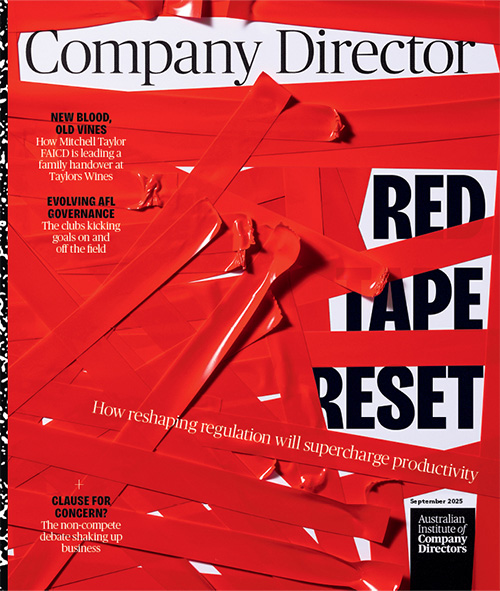How does a school board guide a school’s strategic direction in this fast- changing world? What strategic risks and opportunities do they face and how can boards establish structure and policy to successfully address them? An edited version of an AICD webinar held in March 2024.
The school stakeholder environment has changed dramatically over the past 10–20 years and boards are expected to be aware of, and have some level of engagement with, those stakeholders. In a school context, this engagement becomes more nuanced, because often there are embedded and also interested stakeholders, including caregivers, parents, staff and students, said Kerryn Newton FAICD, CEO of Directors Australia.
“There are also other stakeholders, including funders — funding being one of the strategic risks for schools — but also donors, and making sure we have good relationships with donors and others who speak well of the school,” she said. “Most schools are dependent on their school support groups, their volunteers who run various aspects of the school, so they’re another important stakeholder group. One of the key things boards want to do is to understand what our stakeholders want from us. What are their needs, what are their wants? How do we make sure we canvas those views and use them to shape strategy?”
Strategy and risk are interrelated
By setting strategy, boards are inherently expressing risk appetite in some way and inherently looking at risk and opportunity. Sovereign risk includes changes in federal and state government legislation and compliance, while employment market shortages have created a bidding war that is increasing the cost of delivering education, said Allan Shaw (pictured above), an ambassador for Independent Schools Victoria, external adviser to the board of the Victorian Academy of Teaching and Leadership and a council member at Geelong Grammar School. This includes finding and hiring quality principals and board members.
Karen Spiller OAM CF FAICD was principal of schools in Queensland, including St Aidan’s Anglican Girls’ School and John Paul College, for 23 years. She has also been the chair of the Association of Heads of Independent Schools Australia and the Alliance of Girls Schools Australasia. Spiller noted schools of the future do not have to run as schools in the past have been run. “Is the current model now fit for purpose? That is a strategic issue for boards to consider,” she said. “It’s a long-term task and not an easy issue to wrestle with, but it needs to be considered.”
Most schools tend to have a set of values, and vision and mission statements, but unless those values and mission statements are lived out appropriately, then your school culture will tend to become cynical, and that’s not far removed from becoming toxic, said Spiller.
“One of the things I’d suggest boards wrestle with is that if you have a set of school values, what do you expect to see occur in the school? What do you expect to see if those values are acted out positively?”
Build a strong school culture
Spiller added that with so many stakeholders in the mix, it’s best to be able to fall back to something bedrock and foundational. She suggested methods and practices need to be put in place to hold people accountable and help everyone to understand, “This is how we do business around here. This is how we treat each other. This is how we act. That builds a stronger school culture.”
Schooling is a “people business” and change for many people is really tough work, said Shaw. “You cannot over-communicate what you do, why you do it and how you’re bringing about your strategic implementation.”
Strategy timeframes need to be developed for the short and long term to cover issues including senior staffing pipelines, cyber and technology advances, mental health and psychosocial workplace hazards, financial planning, and property and capital investment. These have to be more than a wish list and need long-term horizon strategic planning.
Students at the centre
Boards should keep in mind the lifetime of a student in a school when thinking about change, and how disruptive it could potentially be to the learning experience. “If you’re undertaking some major strategic shift, then it’s akin to re-engineering an aircraft while it’s in the air,” said Shaw. “That little analogy usually brings home to people just how complex and potentially dangerous implementation can be. That’s not to say, don’t do it. But it’s important to understand it will take time and has to be done carefully.”
Only 60 per cent of webinar participants said their boards were regularly looking at the top 10 strategic risks faced by their school. Risk lists on a board’s agenda might stretch to 40 items, said Newton, which all needed oversight, but with a strategy of prioritisation. What does a good risk management framework look like at a board level?
“In an environment of increasing compliance, risk and opportunity, those management processes and frameworks are absolutely critical,” said Newton. “The ISO [education industry compliance] standard specifically has picked up on key elements to give you confidence that the framework is effective and appropriately resourced.”
Future-fit boards
Spiller advised to develop a matrix of skills required from the board members that will guide and deliver on that strategic plan at board level and effectively govern the school. This could include skills, experience and diversity, along with a set of personal attributes that every school board member is expected to retain. This will help to identify any gaps that need to be addressed. Connection to the school from past students or parents, current parents or donors needs the right balance, with some independence and skills, and a careful watch on conflicts of interest, she said.
Shaw stressed the board had to acknowledge the nuances of school governance and have an understanding of the principal’s role.
“The principal is the chief educator,” he said. “They have to be a registered teacher, but also be the CEO, sometimes of a $100m-plus business. They need to be the chief visionary and chief storyteller. It’s hard for a board to understand all of those facets of the principal’s role — that they need to stand on the soccer field sidelines on Saturday morning and know children’s names and be able to talk to the parents about a student’s progress. Equally, they need to be able to report on the master plan, the strategic development or the school cashflow. It’s such a multifaceted role and the board must make sure that the principal is supported in all aspects of that.”
The full recording of this webinar is available here until 14 April 2025. To register for upcoming events, click here.
Latest news
Already a member?
Login to view this content



